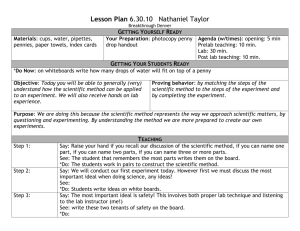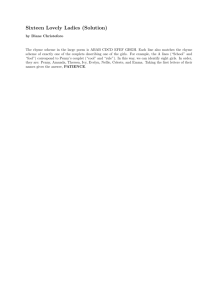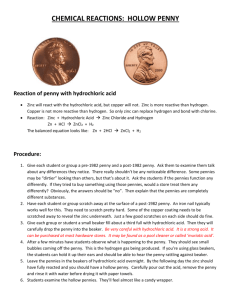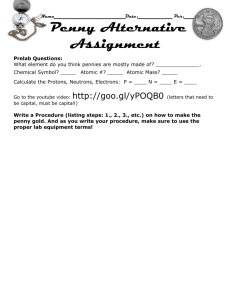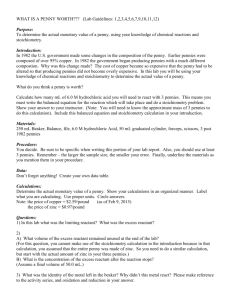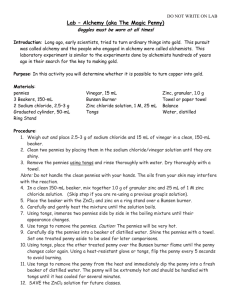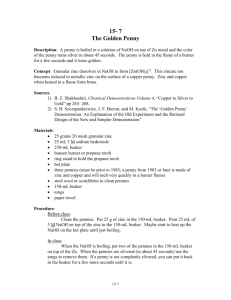Lab 11 - Dr. Vernon-
advertisement
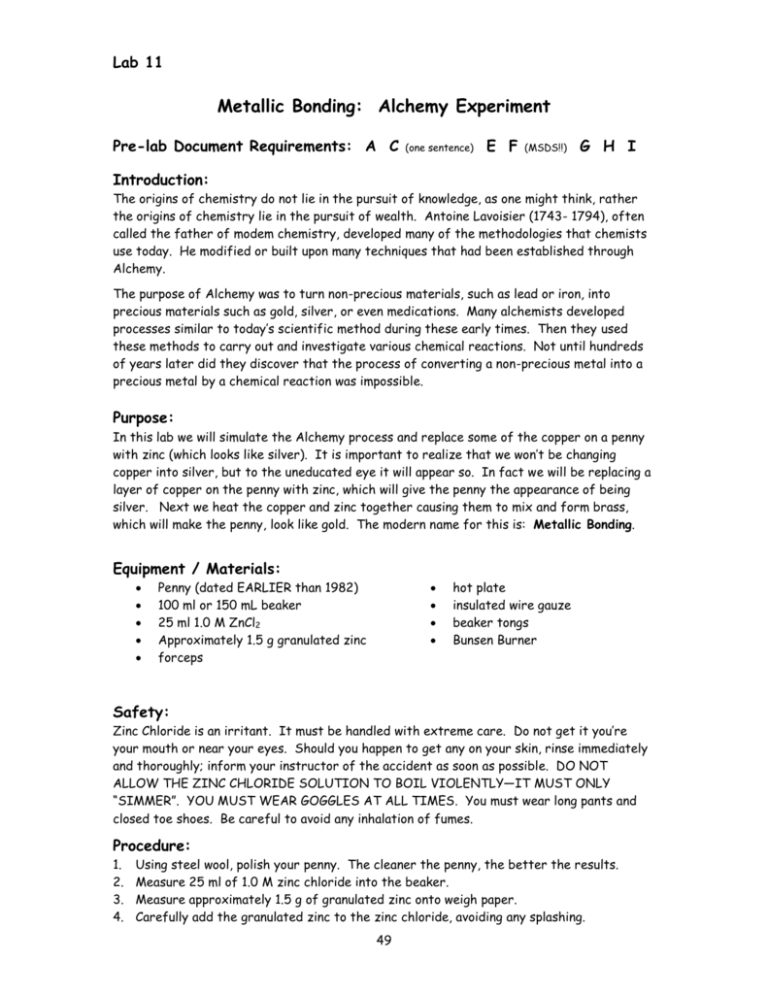
Lab 11 Metallic Bonding: Alchemy Experiment Pre-lab Document Requirements: A C (one sentence) E F (MSDS!!) G H I Introduction: The origins of chemistry do not lie in the pursuit of knowledge, as one might think, rather the origins of chemistry lie in the pursuit of wealth. Antoine Lavoisier (1743- 1794), often called the father of modem chemistry, developed many of the methodologies that chemists use today. He modified or built upon many techniques that had been established through Alchemy. The purpose of Alchemy was to turn non-precious materials, such as lead or iron, into precious materials such as gold, silver, or even medications. Many alchemists developed processes similar to today’s scientific method during these early times. Then they used these methods to carry out and investigate various chemical reactions. Not until hundreds of years later did they discover that the process of converting a non-precious metal into a precious metal by a chemical reaction was impossible. Purpose: In this lab we will simulate the Alchemy process and replace some of the copper on a penny with zinc (which looks like silver). It is important to realize that we won’t be changing copper into silver, but to the uneducated eye it will appear so. In fact we will be replacing a layer of copper on the penny with zinc, which will give the penny the appearance of being silver. Next we heat the copper and zinc together causing them to mix and form brass, which will make the penny, look like gold. The modern name for this is: Metallic Bonding. Equipment / Materials: Penny (dated EARLIER than 1982) 100 ml or 150 mL beaker 25 ml 1.0 M ZnCl2 Approximately 1.5 g granulated zinc forceps hot plate insulated wire gauze beaker tongs Bunsen Burner Safety: Zinc Chloride is an irritant. It must be handled with extreme care. Do not get it you’re your mouth or near your eyes. Should you happen to get any on your skin, rinse immediately and thoroughly; inform your instructor of the accident as soon as possible. DO NOT ALLOW THE ZINC CHLORIDE SOLUTION TO BOIL VIOLENTLY—IT MUST ONLY “SIMMER”. YOU MUST WEAR GOGGLES AT ALL TIMES. You must wear long pants and closed toe shoes. Be careful to avoid any inhalation of fumes. Procedure: 1. 2. 3. 4. Using steel wool, polish your penny. The cleaner the penny, the better the results. Measure 25 ml of 1.0 M zinc chloride into the beaker. Measure approximately 1.5 g of granulated zinc onto weigh paper. Carefully add the granulated zinc to the zinc chloride, avoiding any splashing. 49 5. Gently heat the mixture on the hot plate. DO NOT BOIL—IT MUST ONLY “SIMMER”. Be aware that the mixture will heat very quickly. 6. Gently add your penny (or pennies if both partners want a “gold” penny) to the solution using the forceps. You may do this as soon as the beaker is on the hotplate. 7. The pennies should be on the zinc granules but they should not touch each other. 8. If the solution is near boiling (more than just “simmering”), use the beaker tongs to remove the beaker from the hot plate for a moment. 9. Continue heating the mixture gently until the zinc replaces the copper on the outside of the penny, turning it a silver color. 10. Turn the pennies over during the heating process to make sure the silver color is uniform on both sides. 11. Remove the mixture from heat and then use the forceps to remove the penny from the mixture. DO NOT TOUCH THE PENNY. 12. Gently rinse the penny for several seconds under running water. 13. Adjust the forceps so that you are holding the penny on its edge. 14. Move the penny through the Bunsen burner flame several times until the alloy forms. DO NOT HOLD THE PENNY IN THE FLAME. If you leave the penny in the flame too long—you will ruin your experiment. 15. When finished, be careful not to touch the penny until it has cooled. Clean Up: Pour the mixture of zinc and zinc chloride into the waste beaker. Rinse your 100/150 ml beaker several times. Clean up the lab area. Observations: Record your observations on how the penny changed. You may use a table format, list, or a paragraph. You might comment on things like “before and after”. Summary Questions: Answer the following questions in complete sentences in your lab report. 1. What alloy was formed? What metals make up the alloy? (See your notes or your text book to answer this question.) 2. The actual alloy was not formed until the last step when the zinc-coated penny was moved through the flame. Explain the role of heat energy in forming the alloy. 3. Thoroughly describe the metallic bond formed in the experiment (in other words, what is bonded to what?). Use a diagram if necessary. 4. Were Alchemists ever able to change iron or lead into gold or silver by chemical reactions? 50
